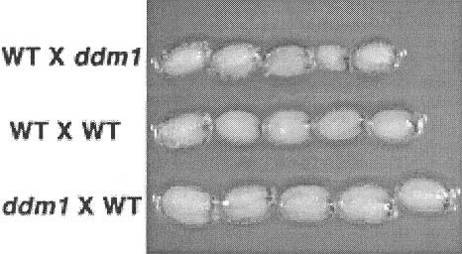Seed Size Regulation using Parent-Specific Hypomethylation
BACKGROUND: In plants, hypomethlyation of genomic DNA helps regulate seed size. At present, antisense MET1 transgenic plants can be used for creating seeds with increased size and weight. However, the dominant nature of MET1 means that a parent's genome, the genome of its gametophytes, and both sets of chromosomes inherited by the seed (maternal and paternal) are all hypomethylated. Hypomethylation of both sets of chromosomes causes reduced fertility and makes it impossible for a plant geneticist to use hypomethylation to differentiate between maternal and paternal genomes in the seed when setting up crosses.DESCRIPTION: University of California researchers have invented an alternative hypomethylation method for controlling seed size using a recessive ddm1 mutation. Since ddm1 is recessive, it displays pronounced parent-of-origin effects. Moreover, it does not have undesirable side effects like reduced fertility. In figure 1, a cross involving a maternal ddm1 and a paternal wild-type shows significant increases in seed size. The size data are summarzied in table 1.
APPLICATIONS: This invention might find application in a wide variety of transgenic crops and other genetically-engineered plants where increased seed sizes are desired.
ADVANTAGES: The ddm1 hypomethylation method can significantly increase seed size while maintaining fertility and allowing one to distinguish between the hypomethylation of maternal- and paternal-source genomic material in the F1 offspring.
REFERENCE: 2007-128
Attached files:


Type of Offer: Licensing
« More Genetics Patents
« More Agriculture Patents
